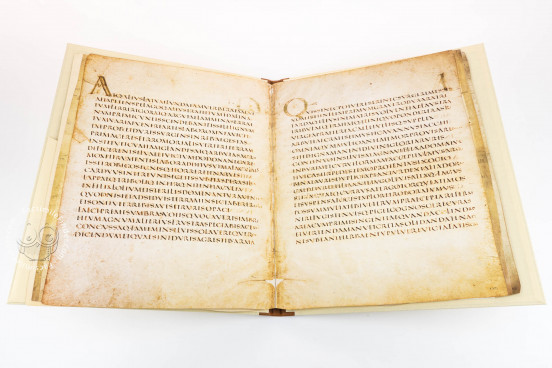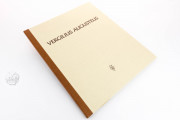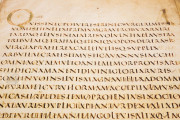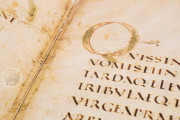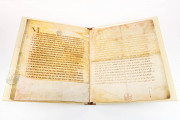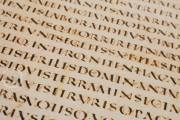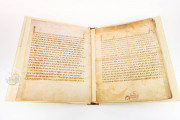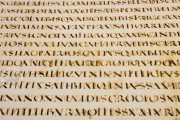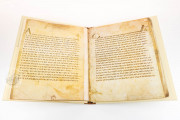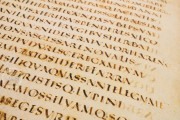The seven remaining folios of the Codex Augusteus are all that remains of the original 330, however these provide a crucial insight into the design and production of Roman literary books. Written in the late fourth century, the book once contained the major works of Virgil. Now, only fragments of Georgics I and III remain.
The superior quality of the vellum and uncial script points to a wealthy patron with an interest in Classical literature at a time of social and economic instability. Its fourteen decorated initials mark the beginnings of textual embellishment that would flourish throughout the medieval period.
A large volume of such quality was likely produced in Rome. The enlarged initials were drawn with the aid of drafting tools suggesting a sophisticated workshop of scribes. It is unknown when the book was dismantled. Of the seven remaining folios, four are in the Vatican and three are in Berlin.
The Beginnings of Decorated Letters
Each page begins with an enlarged initial letter. Unlike the later medieval practice of dropping the initial down over multiple lines, the initials of the Codex Augusteus extend up about four times the height of the body text. For letters such as O that use more horizontal space when enlarged, the rest of the line has been squeezed to fit suggesting this treatment of initial letters was new to this manuscript and not part of the exemplar.
The initial letter of the page is enlarged regardless of its meaning in the text and are purely decorative rather than functional, such as to mark the beginnings of books or chapters. Colors are limited to pale yellow, green and red and each letter is elaborated with geometric designs.
"Burdens More than Books"
The Codex Augusteus provides insight into the Roman upper class at the end of the Empire. The 330 large folios measuring 42.5 by 34.5 cm would have weighed in at over fourteen kilograms producing a volume of the sort decried by Jerome as being a burden more than a book. Jerome was also unhappy about the frivolity of the decorated letters calling such things litteris uncialibus—toll-high letters. His condemnation may be why this page design would not be seen again for another two centuries.
One Book in Two Libraries
Little is known about the life of the Codex Augusteus until the end of the sixteenth century, when Claude Dupuy acquired the Vatican folios from St. Denis. These were gifted to Fulvio Orsini and entered into the Vatican's collection in 1600. The Berlin folios were purchased at auction in 1862 by G.H. Pertz. They had been put up for sale in The Hague by the Limborch family, perhaps acquired from Pierre Pithou (d. 1697), whose ancestors, Pierre and François Pithou, were avid collectors.
We have 1 facsimile edition of the manuscript "Codex Augusteus": Vergilius Augusteus facsimile edition, published by Akademische Druck- u. Verlagsanstalt (ADEVA), 1976
Request Info / Price
